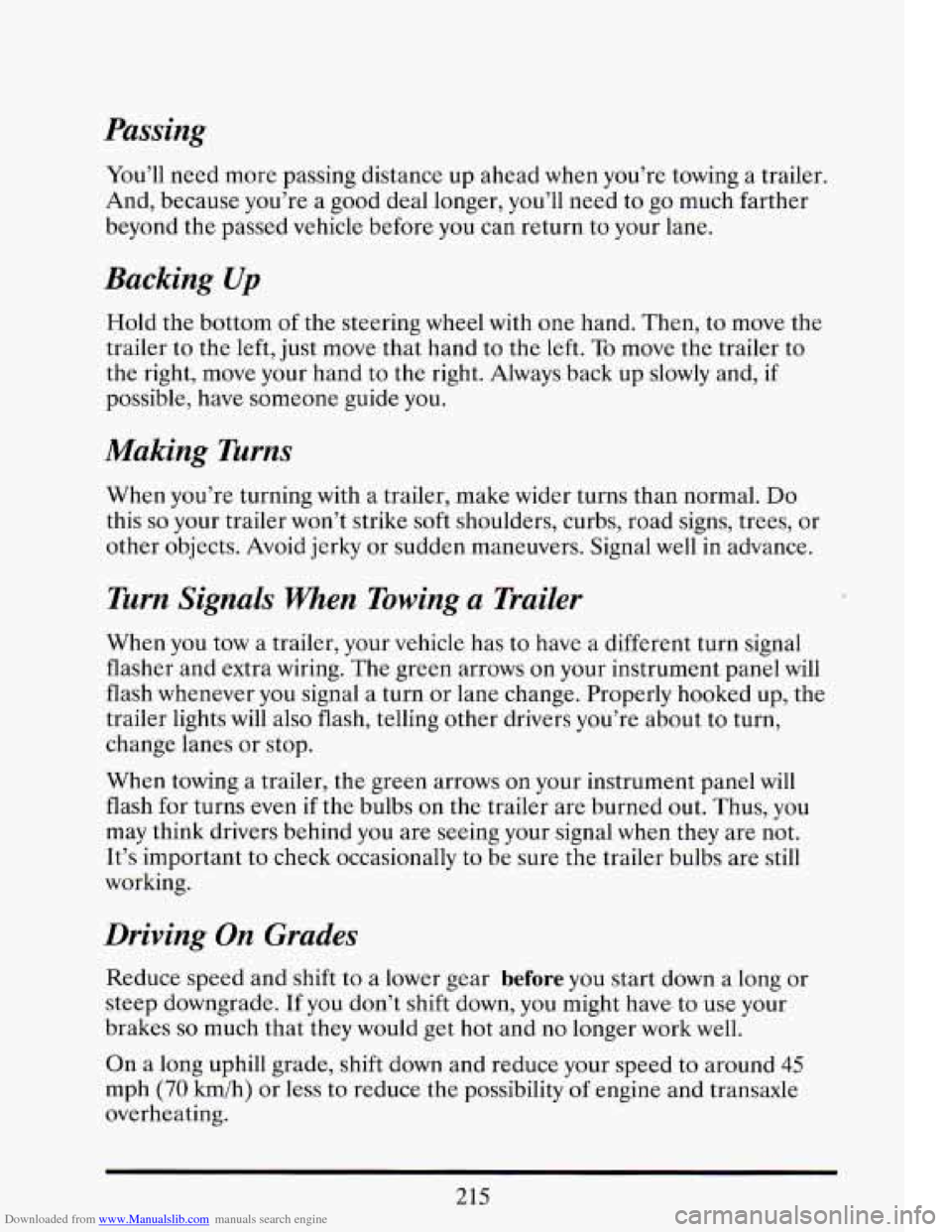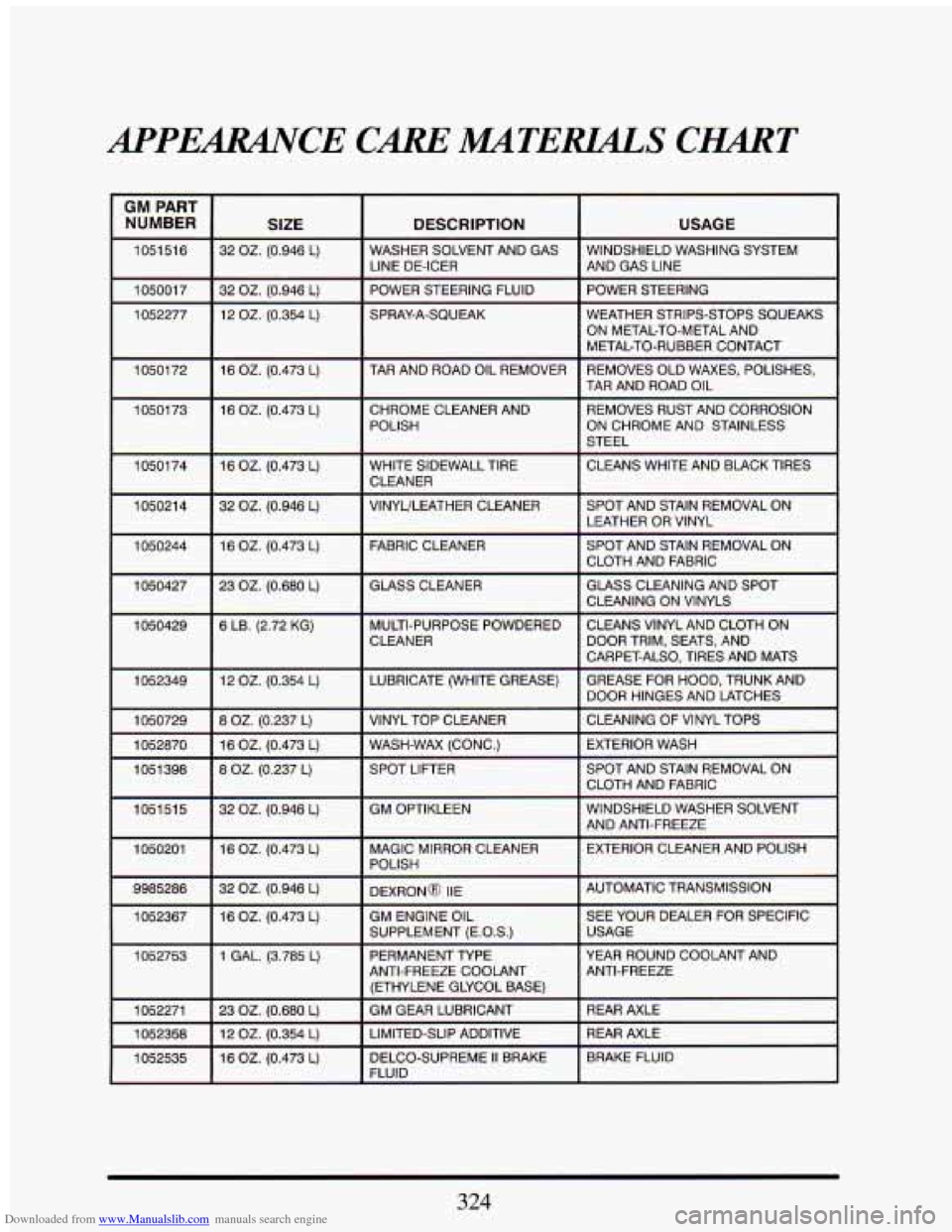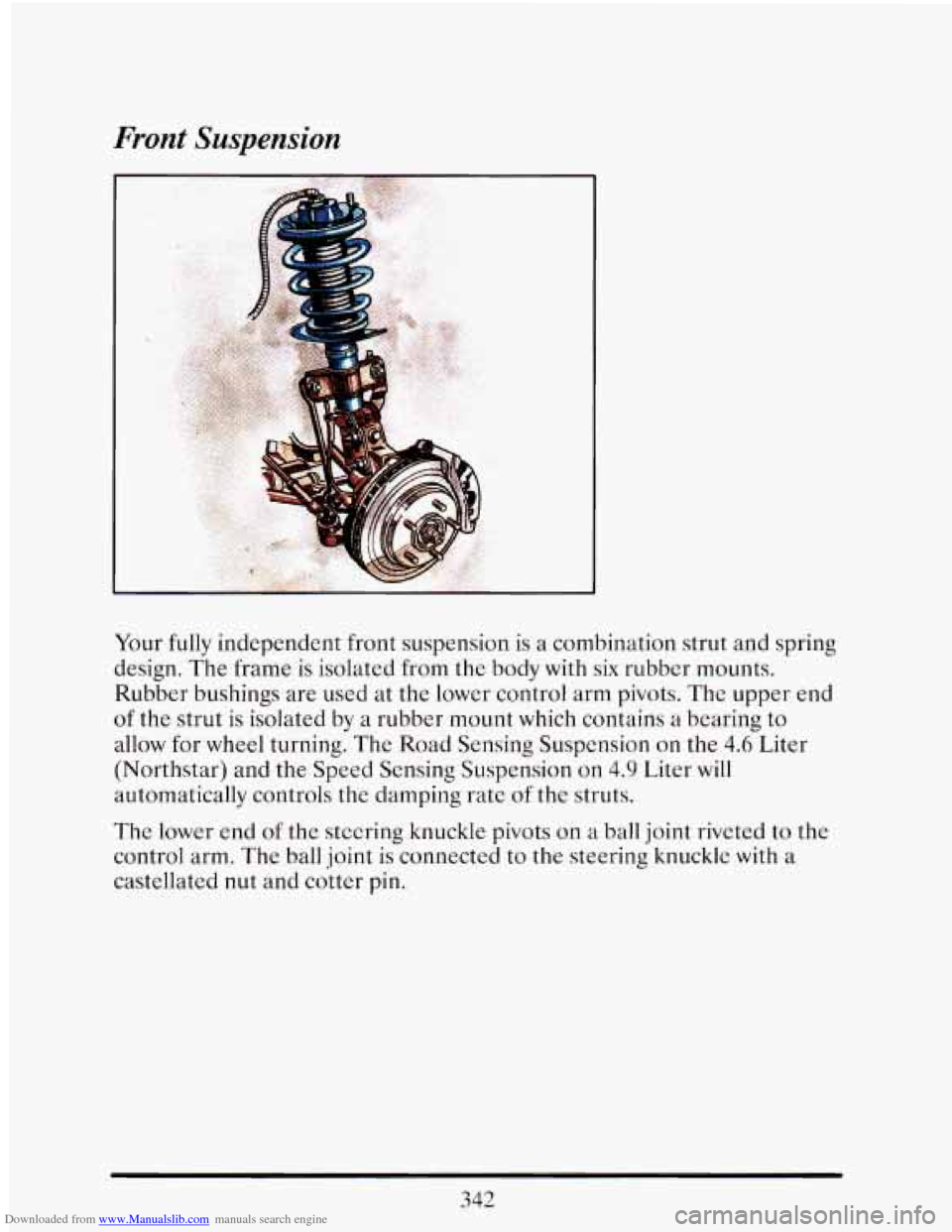1993 CADILLAC ELDORADO steering
[x] Cancel search: steeringPage 229 of 398

Downloaded from www.Manualslib.com manuals search engine Passing
You’ll need more passing distance up ahead when you’re towing a trailer.
And, because you’re a good deal longer, you’ll need
to go much farther
beyond the passed vehicle before you can return to your lane.
Backing Up
Hold the bottom of the steering wheel with one hand. Then, to move the
trailer to the left, just move that hand to the left.
To move the trailer to
the right, move your hand to
the right. Always back up slowly and, if
possible, have someone guide you.
Making Turns
When you’re turning with a trailer, make wider turns than normal. Do
this so your trailer won’t strike soft shoulders, curbs, road signs, trees, or
other objects. Avoid jerky or sudden maneuvers. Signal well
in advance.
Turn Signals When Towing a Trailer
When you tow a trailer, your vehicle has to have a different turn signal
flasher and extra wiring. The green arrows on your instrument panel will
flash whenever
you signal a turn or lane change. Properly hooked up, the
trailer lights will also flash, telling other drivers you’re about to turn,
change lanes or stop.
When towing a trailer, the green arrows on your instrument panel will
flash for turns
even if the bulbs on the trailer are burned out. Thus, you
may think drivers behind you are seeing your signal when they are not.
It’s important to check occasionally to be sure the trailer bulbs are still
working.
Driving On Grades
Reduce speed and shift to a lower gear before you start down a long or
steep downgrade.
If you don’t shift down, you might have to use your
brakes
so much that they would get hot and no longer work well.
On a long uphill grade, shift down and reduce your speed to around
45
mph (70 km/h) or less to reduce the possibility of engine and transaxle
overheating.
215
Page 243 of 398

Downloaded from www.Manualslib.com manuals search engine r
I
I
r- 1-
i-
i-
1
A CAUTION:
To help avoid injury to you or others:
0
0
0
0
0
0
Never let passengers ride in a vehicle that is being towed.
Never tow faster than safe or posted speeds.
Never tow with damaged parts not fully secured.
Never get under your vehicle after it has been lifted by the
tow truck.
Always use separate safety chains on each side when towing a
vehicle.
Never use
“J” hooks. Use T-hooks instead.
When your vehicle is being towed, have the ignition key off. The steering
wheel should be clamped in
a straight-ahead position, with a clamping
device designed for towing service.
Do not use the vehicle’s steering
column lock for this. The transaxle should be in Neutral and the parking
-
F brake released.
Don’t have your vehicle towed on the front wheels, unless you must.
If
the vehicle must be towed on the front wheels, don’t go more than 55
mph (88 km/h) or farther than 500 miles (804 lun) or your transaxle will
be damaged.
If these limits must be exceeded, then the front wheels have
to. be supported on a dolly.
c
m
IC
229
Page 260 of 398

Downloaded from www.Manualslib.com manuals search engine 4. Put the cap back on
the coolant surge
tank.
5. Start the engine and as the engine runs the coolant will circulate
through the cooling system. Any air that was introduced while adding
coolant will purge itself and rise to the top of the surge tank.
If the
“ENGINE COOLANT LOW” message does not appear on the
Driver Information Center, coolant is at the proper
fill level. If an
“ENGINE COOLANT LOW” message does appear, repeat steps
1
through 4 or see your dealer.
IFA TIRE GOES FLAT
It’s unusual for a tire to “blow out7’ while you’re driving, especially if you
maintain
your tires properly. If air goes out of a tire, it’s much more likely
to leak out slowly. But if you should ever have a “blowout,” here are a
few tips about what to expect and what to do:
If a front tire fails, the flat tire
will create a drag that pulls the vehicle
toward that side. Take your foot off the accelerator pedal and grip the
steering wheel firmly. Steer to maintain lane position, then gently brake
to
a stop well out of the traffic lane.
A rear blowout, particularly on a curve, acts much like
a skid and may require
the same correction you’d use in a skid. In any rear blowout, remove your
foot from the accelerator pedal. Get the vehicle under control by steering the
way you want the vehicle
to go. It may be very bumpy and noisy, but you can
still steer. Gently brake to
a stop, well off the road if possible.
If your tire goes flat, the next section shows how to use your jacking
equipment to change a flat tire safely.
246
Page 271 of 398

Downloaded from www.Manualslib.com manuals search engine If you let your tires spin at high speed, they can explode and you
or others could be injured. And, the transaxle or other parts of
the vehicle can overheat. That could cause an engine
compartment fire or other damage. When you’re stuck, spin the
wheels as little as possible. Don’t spin the wheels above
35 mph
(55 km/h) as shown on the speedometer.
-3pannmg your
H ; can destroy parts of your v( cle as well
I as the tires. If you spin the wheels too fast while shifting your
transaxle back and forth, you can destroy your transarj
.
Rocking your vehicle to get it out:
First, turn your steering wheel left and right. That will clear the area
around your front wheels. Then shift back and forth between
“R’
(Reverse) and a forward gear, spinning the wheels as little as possible.
Release the accelerator pedal while you shift, and press lightly on the
accelerator pedal when the transaxle is in gear.
If that doesn’t get you out
after
a few tries, you may need to be towed out. If you do need to be
towed out, see “Towing
Your Vehicle” in the Index.
257
Page 299 of 398

Downloaded from www.Manualslib.com manuals search engine POWER STEERING FLUID
I
4.6 Liter (Northstar)
.. . .. .. '.
How To Check Power Steering Fluid:
Unscrew the cap and wipe the dipstick with a clean rag. Replace the cap
and completely tighten it. Then remove the cap again and
look at the
fluid
level on the dipstick.
285
Page 338 of 398

Downloaded from www.Manualslib.com manuals search engine GM PART
NUMBER
SIZE I DESCRIPTION USAGE
1051516 WINDSHIELD WASHING SYSTEM
AND GAS LINE 32 OZ. (0.946 L) WASHER SOLVENT AND GAS
105001 7 POWER STEERING
WEATHER STRIPS-STOPS SQUEAKS ON METAL-TO-METAL AND
METAL-TO-RUBBER CONTACT
1052277
I 1050172 I
16 OZ. (0.473 L) I TAR AND ROAD OIL REMOVER
I
REMOVES OLD WAXES, POLISHES,
TAR AND ROAD OIL
I
CHROME CLEANER AND
POLISH ' REMOVES RUST AND CORROSION
ON CHROME AND STAINLESS
STEEL
CLEANS WHITE AND BLACK TIRES
WHITE SIDEWALL TIRE
SPOT AND STAIN REMOVAL ON
LEATHER
OR VINYL
SPOT AND STAIN REMOVAL ON
CLOTH AND FABRIC
I 1050427 I I GLASS CLEANER I 23 OZ. (0.680 L) GLASS CLEANING AND SPOT
CLEANING ON VINYLS
I
1050429 6 LB. (2.72 KG)
I
MULTI-PURPOSE POWDERED
CLEANER CLEANS VINYL AND CLOTH
ON
DOOR TRIM, SEATS, AND
CARPET-ALSO. TIRES AND MATS
1052349 12 Of. (0.354 L) LUBRICATE (WHITE GREASE)
1050729 8 OZ. (0.237 L) VINYL TOP CLEANER
1052870
16 OZ. (0.473 L)
WASH-WAX (CONC.) GREASE FOR HOOD, TRUNK
AND
DOOR HINGES AND LATCHES
CLEANING
OF VINYL TOPS
EXTERIOR WASH
SPOT AND STAIN REMOVAL ON
CLOTH AND FABRIC
WINDSHIELD WASHER SOLVENT AND ANTI-FREEZE
1051 398 8 OZ. (0.237 L) SPOT LIFTER
1051515 32 OZ. (0.946 L) GM OPTIKLEEN
EXTERIOR CLEANER AND POLISH
16 OZ. (0.473 L) MAGIC MIRROR CLEANER
POLISH
32 OZ. (0.946 L) DEXRONQ IIE I 9985286 AUTOMATIC TRANSMISSION
SEE YOUR DEALER
FOR SPECIFIC
USAGE 1 1052367 I SUPPLEMENT (E.0.S.I I 16 OZ. (0.473 L) GM
ENGINE OIL I
YEAR ROUND COOLANT AND
ANTI-FREEZE 1 GAL. (3.785 L) PERMANENT TYPE
ANTI-FREEZE COOLANT
16 OZ. (0.473 L) DELCO-SUPREME II BRAKE
1052753
REAR AXLE
REAR AXLE
BRAKE FLUID
I I I FLUID 1
324
Page 343 of 398

Downloaded from www.Manualslib.com manuals search engine 1nrVc-I
SENSE
I I
BIII mc 1 m DRL
SUSPENSION RTD (BAT)
L HDLP LO
R HDLP LO L HDLP HI R HDLP HI
-1
COOL FAN TRANS/ECS
FUSE CENTER IDENTIFICATION I
ENGINE COMPARTMENT FUSE BLOCK
COIL 20A - 4.9L DISTRIBUTOR - 4.6L IGNITION CONTROL MODULE SIR 20A - DIAGNOSTIC ENERGY RESERVE MODULE
- ARMING SENSOR
- POWERTRAIN CONTROL MODULE (PCM) (DERM) SIR (AIR BAG)
PCM (IGN) 10A - PASSKeyB DECODER MODULE
INJ 10A
INJ 10A
IGN 10A
- FUEL INJECTORS 1,4,6,7
- FUEL INJECTORS 2,3,5,8
- A/C COMPRESSOR - ELECTROCHROMIC MIRROR - INSTRUMENT PANEL CLUSTER - DIAGNOSTIC ENERGY RESERVE MODULE
- KEYLESS ENTRY MODULE - CORNERING LIGHTS - CHIME MODULE - TWILIGHT SENTINEVDRL MODULE - BACKUP LIGHTS - BRAKE TRANSMISSION SHIFT INTERLOCK (DERM)
SIR (AIR BAG)
FUEL 20A
- FUELPUMP - POWERTRAIN CONTROL MODULE
PCM (BAT) 10A
A/C 1OA
HTD
W/S 10A
STOP LP 20A
TURN/HAZ 20A
- POWERTRAIN CONTROL MODULE (PCM)
- A/C COMPRESSOR
- HEATED WINDSHIELD
- STOP LIGHTS
- HAZARD LIGHTS - TURN SIGNAL LIGHTS DRL
1OA (CANADA)
DRL 1OA (CANADA)
SUSPENSION 10A
- DAYTIME RUNNING LIGHTS
- DAYTIME RUNNING LIGHTS
- ROAD SENSING SUSPENSION
- SPEED SENSITIVE SUSPENSION (4.9L)
- ROAD SENSING SUSPENSION (NORTHSTAR)
RTD (BAT) 20A
L HDLP LO 1 OA (EXPORT)
R HDLP LO 1OA (EXPORT)
L HDLP HI 10A (EXPORT)
R HDLP HI (EXPORT)
IGN
3 10A
- LEFT HEADLAMP LOW BEAM
- RT HEADLAMP LOW BEAM
- LEFT HEADLAMP HIGH BEAM
- RIGHT HEADLAMP HIGH BEAM
- HEATED WINDSHIELD - HEATER AND A/C PROGRAMMER - ELECT. LEVEL CONTROL (ELC) - DEFOGGER RELAY “D”
- CRUISE CONTROL - POWERTRAIN CONTROL MODULE
- COOLING FANS - POWERTRAIN CONTROL MODULE (4.6L) - FRONT AND REAR HEATED OXYGEN
COOLING
FAN 10A
SENSOR (4.6L)
TRANS/ECS
1 OA
SOLENOID - EXHAUST GAS RECIRCULATION (EGR)
- POWERTRAIN CONTROL MODULE (PCM) - AUTOMATIC TRANSAXLE - EVAPORATIVE EMISSION CONTROL
SOLENOID
- OVERSPEED ALERT MODULE (EXPORT) - POWER STEERING PRESSURE SWITCH
329
Page 356 of 398

Downloaded from www.Manualslib.com manuals search engine Front Suspension
Your fully independent front suspension is a combination strut and spring
design.
The frame is isolated from the body with six rubber mounts.
Rubber bushings are used at
the lower control arm pivots. Thc upper end
of the strut is isolated by a rubber mount which contains a bearing to
allow
for wheel turning. The Road Sensing Suspension on the 4.6 Liter
(Northstar) and the Speed Sensing Suspension on
4.9 Liter will
automatically controls the damping rate of the struts.
The lower end of the steering knuckle pivots on a ball joint riveted to the
control arm. The ball joint is connected to the steering knuckle
with a
castellated
nut and cotter pin.
342